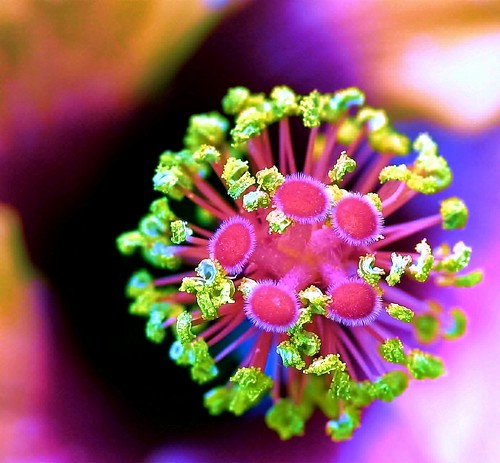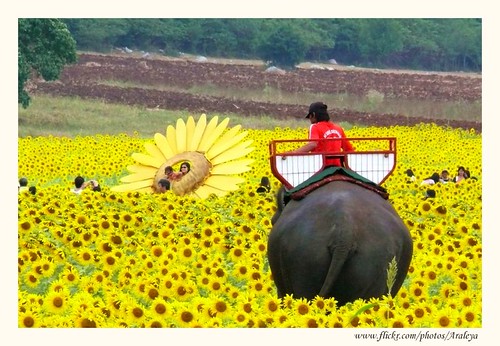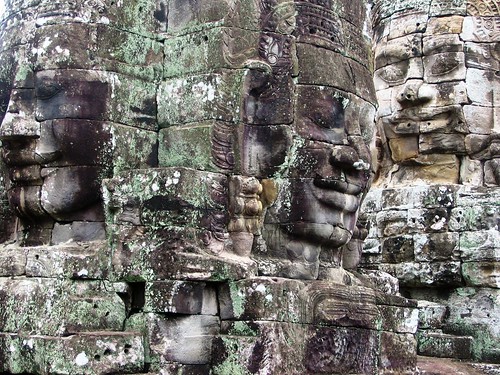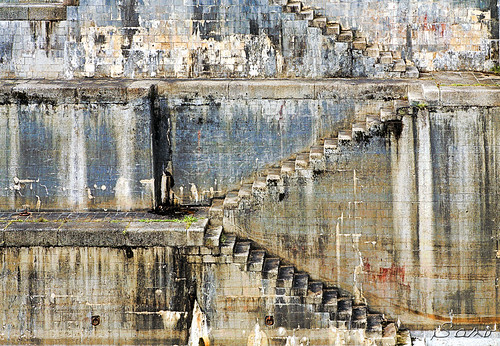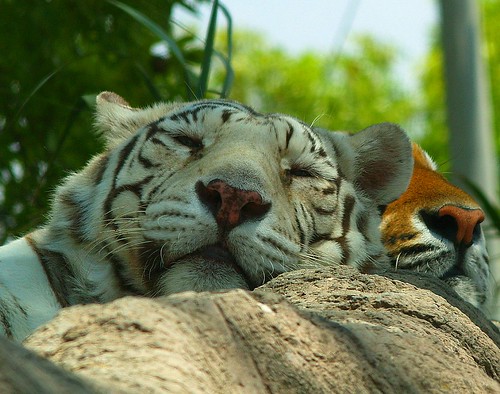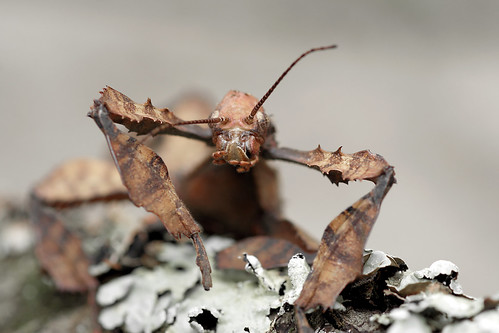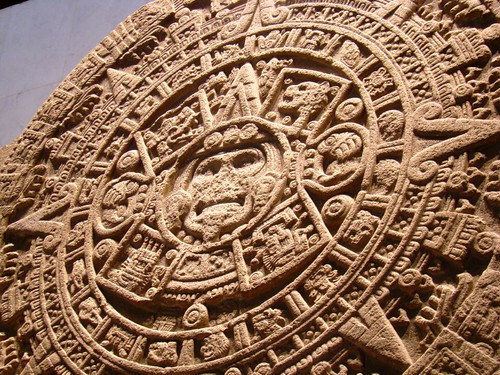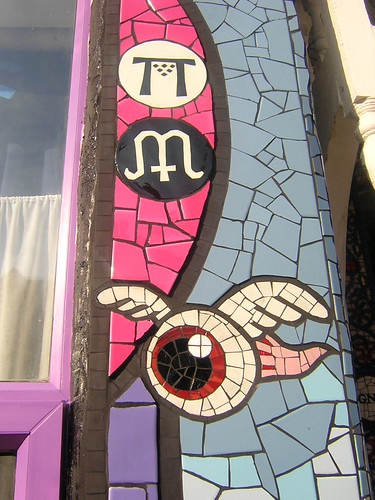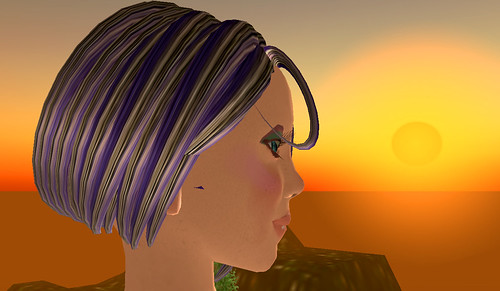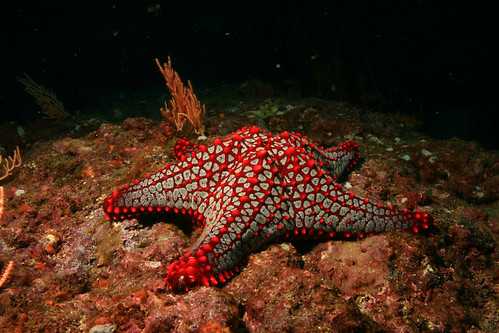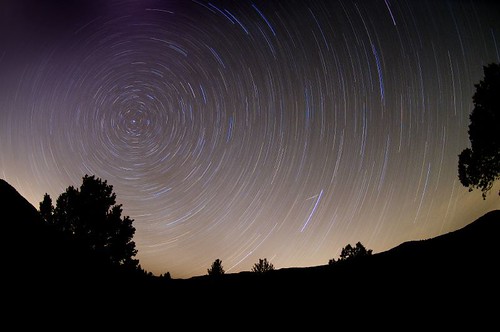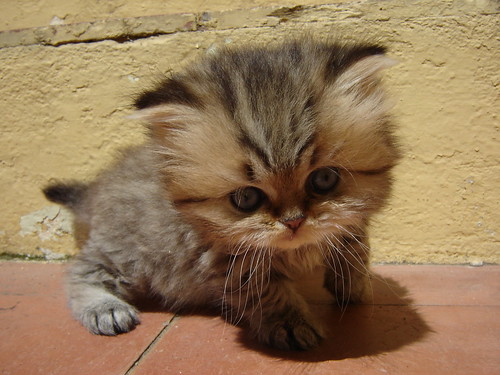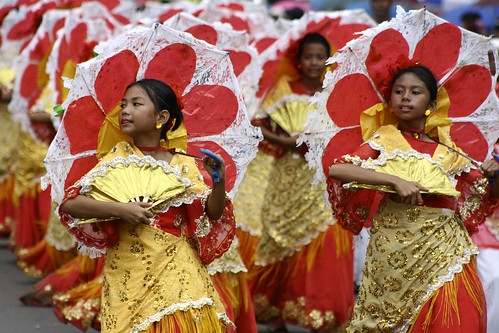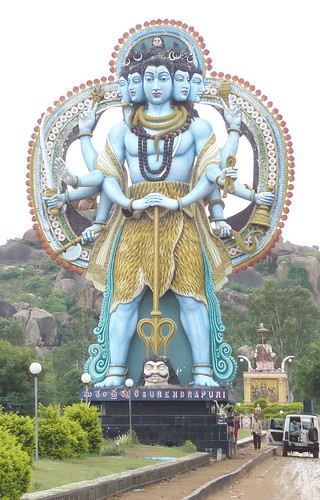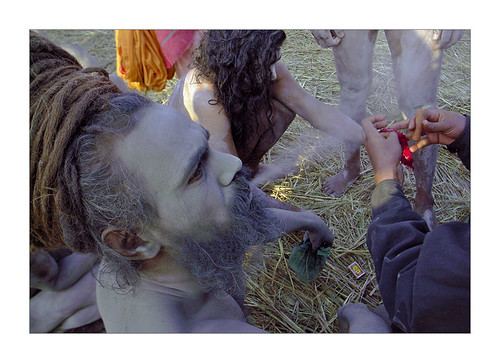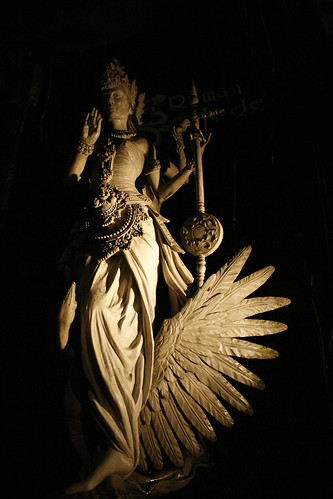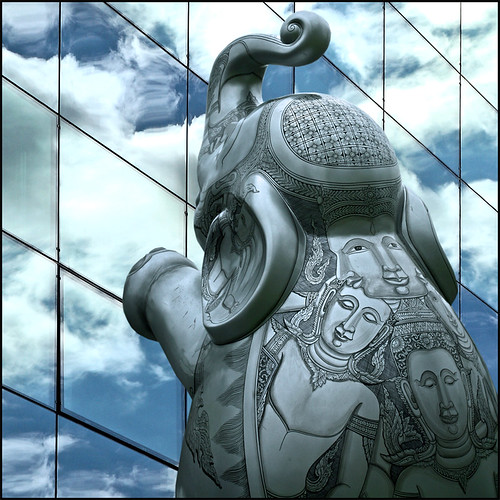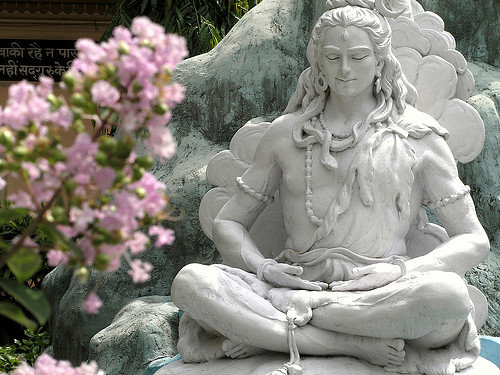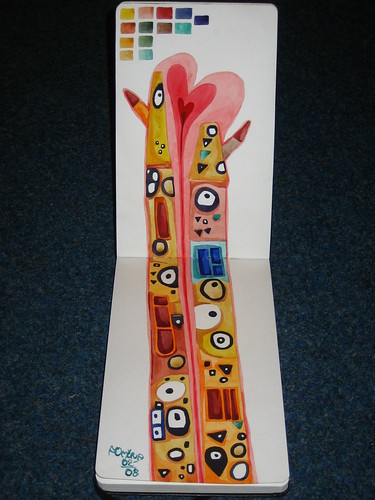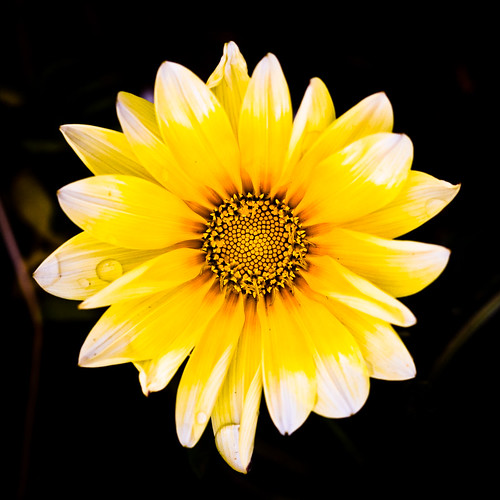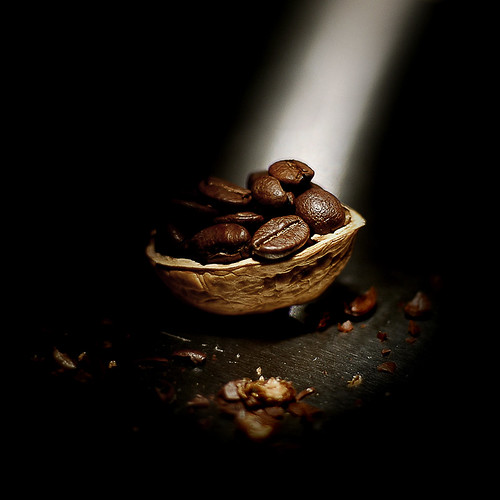"When words escape, flowers speak."
Bruce W. Currie
SLIDE
sábado, 31 de mayo de 2008
Amazing Thailand
On EXPLORE
From November to December it is the season of sunflower blooming. Not far from Bangkok, there is lots of sunflower fields blooming alomst the same time.
Driving and expecting so we found the first sunflower field was so beautiful and stunning with cheerful yellow field, mountain background and lively elephants and people.
As blooming time is not long so it is golden time too. Those elephants added so much the joy in the field. They walk happily in the field. Thai people are familiar with elephant.
The elephant I sat on is 20 years old female elephant called "ลมโชย" or "Breezing Wind". She walked and stopped here and there several times to grasp grass for eating. We was happy as she was happy walking carrying three of us and one owner of hers. We fed her with sugarcane some minutes before we decided to have elephant walk with her. So she may remembered us. The owner didn't push her to walk faster though he could earn more money. I asked why and the owner said let her be happy... and I was so happy to hear that, otherwise I could pay more for more time.
It was bright day, sunny with cloud shadow so the weather was all day comfortable.
I heard happy talks and saw happy smiles all around in those happy colors of flowery field.. .Just another one fine day.
(added)
There is a small road withiin the field so people and elephant could walk without flattening the flowers..There is a temporary tower using as platform for elephant onbard : )))) so we can took location like this but Ithis shot actually took when I was sitting on elephant.. when she walked the world just incline in each step so photo comes like that...
Road from Saraburi rovince - Pattanana nikom
Lopburi, Thailand
Amazing Thailand
Bayon - 3 faces
The Bayon is a well-known and richly decorated Khmer temple at Angkor in Cambodia. Built in the late 12th century or early 13th century as the official state temple of the Mahayana Buddhist King Jayavarman VII, the Bayon stands at the centre of Jayavarman's capital, Angkor Thom. Following Jayavarman's death, it was modified and augmented by later Hindu and Theravada Buddhist kings in accordance with their own religious preferences.
The Bayon's most distinctive feature is the multitude of serene and massive stone faces on the many towers which jut out from the upper terrace and cluster around its central peak. The temple is known also for two impressive sets of bas-reliefs, which present an unusual combination of mythological, historical, and mundane scenes. The main current conservatory body, the JSA, has described the temple as "the most striking expression of the 'baroque' style" of Khmer architecture, as contrasted with the 'classical' style of Angkor Wat.The inner gallery is nearly filled by the upper terrace, raised one level higher again. The lack of space between the inner gallery and the upper terrace has led scholars to conclude that the upper terrace did not figure in the original plan for the temple, but that it was added shortly thereafter following a change in design. Originally, it is believed, the Bayon had been designed as a single-level structure, similar in that respect to the roughly contemporaneous foundations at Ta Prohm and Banteay Kdei.
The upper terrace is home to the famous "face towers" of the Bayon, each of which supports two, three or (most commonly) four gigantic smiling faces. In addition to the mass of the central tower, smaller towers are located along the inner gallery (at the corners and entrances), and on chapels on the upper terrace. "Wherever one wanders," writes Maurice Glaize, the faces of Lokesvara follow and dominate with their multiple presence."
Efforts to read some significance into the numbers of towers and faces have run up against the circumstance that these numbers have not remained constant over time, as towers have been added through construction and lost to attrition. At one point, the temple was host to 49 such towers; now only 37 remain. The number of faces is approximately 200, but since some are only partially preserved there can be no definitive count.
http://en.wikipedia.org/wiki/BayonBayon - 3 faces
Electrocuted Squirrel
It was raining at the RSPB Osprey centre near Loch Garten. This poor red squirrel was looking pretty bedraggled.
Electrocuted Squirrel
viernes, 30 de mayo de 2008
miércoles, 28 de mayo de 2008
Macleay's Spectre
Walkingstick
Phasme tiare, dit aussi Phasme scorpion (Australie)
Extatosoma tiaratum
Stage de macrophoto avec Gilles Martin
Brenne, août 2007
Macleay's Spectre
Ferrofluid
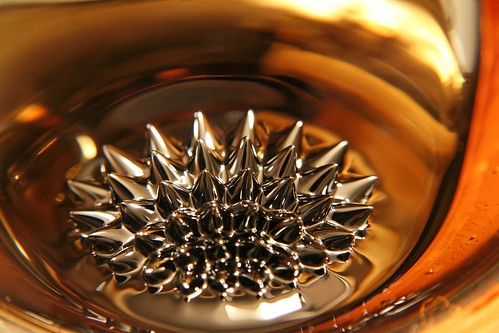
Ferrofluid 3, originalmente cargada por AMagill.
A ferrofluid (from the Latin ferrum, meaning iron) is a liquid which becomes strongly polarised in the presence of a magnetic field. It is a colloidal mixture comprising extremely small magnetic particles suspended in a liquid. The particles are coated with a soap or detergent to prevent them from clumping together.
Ferrofluids are composed of nanoscale ferromagnetic, or ferrimagnetic, particles suspended in a carrier fluid, usually an organic solvent or water. The ferromagnetic nano-particles are coated with a surfactant to prevent their agglomeration (due to van der Waals and magnetic forces). Although the name may suggest otherwise, ferrofluids do not display ferromagnetism, since they do not retain magnetization in the absence of an externally applied field. In fact, ferrofluids display (bulk-scale) paramagnetism, and are often referred as being "superparamagnetic" due to their large magnetic susceptibility. Permanently magnetized fluids are difficult to create at present.
It is important to note the difference between ferrofluids and magnetorheological fluids (MR fluids). The particles in a ferrofluid primarily consist of nanoparticles which are suspended by Brownian motion and generally will not settle under normal conditions. MR fluid particles primarily consist of micron-scale particles which are too heavy for Brownian motion to keep them suspended, and thus will settle over time due to the inherent density difference between the particle and its carrier fluid. These two fluids have very different applications as a result.
Ferrofluids are composed of nanoscale particles (diameter usually 10 nanometers or less) of magnetite, hematite or some other compound containing iron. This is small enough for thermal agitation to disperse them evenly within a carrier fluid, and for them to contribute to the overall magnetic response of the fluid. This is analogous to the way that the ions in an aqueous paramagnetic salt solution (such as an aqueous solution of copper(II) sulfate or manganese(II) chloride) make the solution paramagnetic.True ferrofluids are stable. This means that the solid particles do not agglomerate or phase separate even in extremely strong magnetic fields. However, the surfactant tends to break down over time (a few years), and eventually the nano-particles will agglomerate, and they will separate out and no longer contribute to the fluid's magnetic response. The term magnetorheological fluid (MRF) refers to liquids similar to ferrofluids (FF) that solidify in the presence of a magnetic field. Magnetorheological fluids have micrometre scale magnetic particles that are one to three orders of magnitude larger than those of ferrofluids.
However, ferrofluids lose their magnetic properties at sufficiently high temperatures, known as the curie temperature. The specific temperature required varies depending on the specific compounds used for the nano-particles, surfactant, and carrier fluid.
Ferrofluid
Piedra del Sol
The Aztec sun stone, Stone of the Sun (Spanish: Piedra del Sol) or Aztec calendar stone is a large monolithic sculpture that was excavated in the Zócalo, Mexico City's main square on December 17, 1790.
Measuring about 3.6 meters (12 feet) in diameter, 1.22 meters (4 feet) in thickness and weighing 24 tons, the original basalt version is presently on display at the National Museum of Anthropology in Mexico City's Chapultepec Park.
While it is often called the "Aztec Calendar," it is a symbolic portrayal of the four disasters that led to the demise of the four prior Universes in Aztec cosmology. It also contains a hieroglyphic and pictographic layout of how the Aztecs measured time, and was primarily a religious and cosmological artifact.
The Aztec Calendar page also contains more information on how the Aztecs marked time.
Understanding the Sun Stone
The Aztecs believed that four prior Universes existed and the Sun Stone depicts each one of these iterations. The Aztecs believed that they were living in the fifth and last creation of their world.[citation needed] To this end, the Aztec Sun Stone is dedicated to the sun god Tonatiuh, who was believed to have been the fifth sun god, as a means to prevent further catastrophe and end of the world by performing regular human sacrifices in his honor.
Center
In the center of the sun stone is believed to be either the sun god Tonatiuh or the earth god Tlaltecuhtli. The central figure's tongue is shown to be a sacrificial knife, while the circles on either ends depict claws holding human hearts for sacrificial purposes.
The Four Worlds
The four squares around the central deity depict the previous four suns (the four prior Universes) that perished. On the top right square is depicted the jaguar. Moving to the left is the wind, below the wind is fiery rain and in the bottom right square is water.
The Twenty Days
- Main article: Tonalpohualli
Continuing outward from the inner circle, the next concentric circle consists of twenty squares, each naming one of the twenty different days of the Aztec month. Clockwise, these days are:
- Snake - Coatl
- Lizard - Cuetzpallin
- House - Calli
- Wind - Ehecatl
- Crocodile - Cipactli
- Flower - Xochitl
- Rain - Quiahuitl
- Flint - Tecpatl
- Movement - Ollin
- Vulture - Cozcacuauhtli
- Eagle - Cuauhtle
- Jaguar - Ocelotl
- Cane - Acatl
- Herb - Malinalli
- Monkey - Ozomatli
- Hairless Dog - Itzquintli
- Water - Atl
- Rabbit - Tochtli
- Deer - Mazatl
- Skull - Miquiztli
Each Aztec year consisted of eighteen months and each month had 20 days. Five more dots called Nemontemi were added inside the circle, which depicted days for sacrifice, bringing up the total number of days to 365.
http://en.wikipedia.org/wiki/Piedra_del_sol
Piedra del Sol
Ray of Creation 1
The giver of life mock of us
only a dream we chase
oh my friends
our hearth trust
But he really mock of us
but with emotion we enjoy
in the green things and in the paintings
The giver of life make us live
he knows, he rules
how we, the men, will die
nobody, nobody, nobody
really lives on earth.
Some of the ancient geocentric models don't represent an Earth centered Universe at all, but in reality display the Ray of Creation. This confusion was due to a lack of knowledge on the part of those examining the diagrams. Thus, the Ray of Creation is a part of ancient knowledge.
Ray of Creation 1
Khie - Avatar - Sun
Many New Age teachings have been strongly influenced by Neo-Theosophical ideas (primarily through Alice Bailey), and feature a celestial hierarchy of ascended masters. At the head of the hierarchy is the same being, the Maitreya, that Leadbeater claimed to see in Krishnamurti. Some New Age teachings speak of the coming return of Christ, or the coming of the Maitreya, which will usher in a new cosmic Era. According to Benjamin Creme, the Maitreya has already incarnated, and will soon reveal himself.
Khie - Avatar - Sun
lunes, 26 de mayo de 2008
Star Attraction
The color red, restored by my underwater strobe, neatly accents this sea star at Viuda (Widow) dive site in Coiba National Park, Panama, a UNESCO World Heritage site.
At this depth, all of the natural red light has been filtered out by the seawater and this starfish looks dark brown without the aid of artificial light.
Star Attraction
1 hour North Star
This was a 1 hour exposure of the north star. This was the longest exposure I have tried with my D70s. Photo Taken while in Joe's Valley Utah.
1 hour North Star
viernes, 23 de mayo de 2008
Fuchur
Falkor and Atreyu are flying around the emptiness of space, as the rest of Fantasia is gone, leaving only an asteroid field. With the guide of the Auryn, they fly back to the Ivory Tower, which is the only intact structure left in the remains of Fantasia. Atreyu goes inside the tower and comes face to face with The Childlike Empress (Tami Stronach). The Empress tells him that he has not failed, and has indeed brought a human child with him. The Empress begins to tell of the human child, who escaped bullies in a bookstore, then accompanied Atreyu on his journey all along.
Atreyu (Atréju in German) is a secondary protagonist to the story, being the protagonist of the mysterious book that Bastian reads. To the audience, he is a metafictional character, existing fictionally and within the reality of the book itself.
He is a young Greenskin warrior from the Grassy Plains. His parents were killed by a purple buffalo soon after he was born, so his entire village raised him, thus his name means "son of all" in his native language. He is summoned by the Childlike Empress to embark on a "Great Quest" to save the land of Fantastica by finding a cure for her illness. He is given the Auryn, an amulet that makes whoever wears it the Childlike Empress' herald, and he sets out on his mission with his horse, Artax. During the long events of the quest to find a cure, his travels lead him across all corners of Fantastica. He meets many creatures, including Falkor the luckdragon, who helps him on his quest by carrying him on his back. Bastian, all the while reading Atreyu's story in the real world, experiences everything Atreyu does and begins to sympathize with him. In the end this proves to have been Fantastica's solution and the Empress' cure, bringing Bastian to Fantastica to give the Empress a new name. Atreyu features largely in the second half of the novel, as Bastian travels Fantastica far and wide as its savior.
In the 1984 film version, the character of Atreyu is played by Noah Hathaway. His skin is not olive green as described in the book, though it was attempted to do this through makeup, it never made it to the final production. As such, his people were called the 'Plains People' instead of Greenskins. The character also makes a return appearance in The Neverending Story II: The Next Chapter, played by Kenny Morrison. In the 2001 Hallmark mini-series, Tales from the Neverending Story, he is portrayed by Tyler Hynes and the character's people are referred to as the Woodland People. He is shown to have a romantic relationship with a young aviatrix called "Fly Girl", and to be something of a village innocent.
Falkor (Fuchur in German) is a luckdragon, and a friend of Atreyu. He is the only luckdragon to appear, although five others are mentioned in passing. He helps Atreyu in his quest to find a cure for the Empress after escaping the web of Ygramul the Many.
Falkor has an elongated, wingless body with many white scales, and only rudimentary paws. The form of his head is described less precisely, though his eyes are mentioned as being the color of rubies. A cover for the book by Dan Craig illutrated Falkor as lion-like, while in the 1984 film adaptation of the novel, as well as its sequels, Falkor has distinctive canine features. Additionally, in both the first and second movies, Falkor asks to be scratched behind his ear, accenting his dog-like appearance, which led to confusion among those who have not read the book.
Unlike most of their dragon kin, luckdragons possess neither an immense physical strength, nor great magical talents, though they can still breath fire, as shown when Falkor fights Ygramul. Their only distinctive ability that sets them apart is their incredible luck in everything they do, as shown at one point in the novel when Falkor manages to locate and rescue his companion despite being lost in a violent, blinding storm and having absolutely no idea where to look for him. A luckdragon's typical answer to how it is going to accomplish a nearly impossible feat is always "With luck!" Despite such carelessness, it seems their luck truly never fails and is a valuable asset for their companions.
Another special trait of luckdragons is the ability to fly despite the fact that they have no wings. It is explained in the book that luckdragons are beings made from fire and air, and never stop breathing air and heat through their scales, which makes water deadly to them, although in the both film and the book Falkor retrieves the AURYN from under water on the arm of a coral reef. Luckdragons are capable of sleeping while flying, and prefer to have as much open space as possible rather than be cooped up in a building, regardless of how spacious it may be.
http://en.wikipedia.org/wiki/The_NeverEnding_Story_(film)
Fuchur
The Childlike Empress - La Emperatriz Infantil
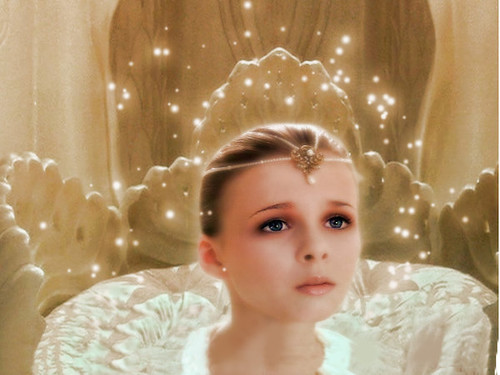
La Emperatriz Infantil, originalmente cargada por kirtash.
The Childlike Empress (Die Kindliche Kaiserin in German) is the monarch of Fantastica, who resides in the Ivory Tower palace in the heart of the realm. Although she is formally the ruler of Fantastica, she does not command a political system and in fact rarely actually interferes with that world. She does not judge between beautiful and ugly or good and evil, being the embodiment of Fantastica itself, which is why all Fantasticans respect and acknowledge her presence and authority. Should she die, Fantastica and all Fantasticans would cease to exist. The amulet known as 'AURYN' is her emblem, and those who wear it are her messengers and representatives. As explained by Morla the Aged One, her lifetime is not measured in years or in time, but by names. She continuously needs new names, which only a human can give to her by coming to Fantastica. When she begins to need a new name, she begins to fade away, causing the Nothing to appear in Fantastica. She sends Atreyu on the Great Quest, which brings Bastian Balthazar Bux to Fantastica, and Bastian gives her the name of 'Moon Child,' which restores Fantastica and begins the second half of the novel.
Her description is that of an indescribably beautiful young girl, possibly no older than ten, yet known to be much older than the oldest Fantasticans. Her hair is snow-white, as is her gown, and her eyes are the color of gold, earning her the official title Golden-eyed Commander of Wishes.
The role was portrayed by Tami Stronach in Wolfgang Petersen's 1984 adaptation, by Alexandra Johnes in The NeverEnding Story II: The Next Chapter (1990) and by Julie Cox in The NeverEnding Story III (1994). In the movies, her hair is dark, rather than white, and in the first movie, she is dressed like a bride.
http://en.wikipedia.org/wiki/The_NeverEnding_Story_(film)
The Childlike Empress - La Emperatriz Infantil
Osteospermum
Osteospermum is a genus belonging to the Calenduleae, one of the smaller tribes of the sunflower family (Asteraceae).
Osteosperum used to belong to the genus Dimorphotheca, but only the annual species remain in that genus; the perennials belong to Osteospermum. The genus Osteospermum is also closely related to the small genus Chrysanthemoides, such as C. incana and C. monilifera.Botanical background
The scientific name is derived from the Greek osteon (= bone) and Latin spermum (= seed). It has been given several common names: African Daisy, South African Daisy, Cape Daisy and Blue-eyed Daisy.
There are about 50 species, native to Africa, 35 species in southern Africa, and southwestern Arabia. They are half-hardy perennials or subshrubs. Therefore they do not survive outdoor wintry conditions, but there is still a wide range of hardiness.
Their alternate (rarely opposite) leaves are green, but some beautiful variegated forms exist. The leaf form is lanceolate. The leaf margin is entire, but hardy types are toothed.
| Osteospermum | ||||||||||||||
|---|---|---|---|---|---|---|---|---|---|---|---|---|---|---|
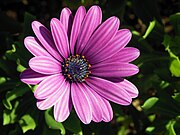 Purple Osteospermum flower | ||||||||||||||
| Scientific classification | ||||||||||||||
|
The daisy-like flowers consists of disc florets and ray florets, growing solitary at the end of branches or sometimes in inflorescences of terminal corymbose cymes. The disc florets are pseudo-bisexual and come in several colors such as blue, yellow and purple. The hardy types usually show a dark blue center in the disc until the yellow pollen is shed. The ray florets are female and are found diverse colors such as white, cream, pink, purple, mauve to yellow. Some cultivars have "spooned" petals such as "Pink Whirls". Many species flower a second time late summer, stimulated by the cooler night temperatures. Hardy types show profuse flowering in the spring, but they do not get a second flush of flowers.
Most widely sold cultivars are grown as annuals and are mainly hybrids of O. jucundum, O. ecklonis and O. grandiflorum and can be hardy to -2°C (30°F). If hardy, they can be grown as perennials or as shrubs.
Culture
Plants prefer a warm and sunny position and rich soil, although they tolerate poor soil, salt or drought well. Modern cultivars flower continuously when watered and fertilised well, and dead-heading is not necessary, because they do not set seed easily. If planted in a container, soil should be prevented from drying out completely. If they do, the plants will go into "sleep mode" and survive the period of drought, but they will abort their flower buds and not easily come back into flower. Moreover, roots are relatively susceptible to rotting if watered too profusely after the dry period.
http://en.wikipedia.org/wiki/Osteospermum
Osteospermum
jueves, 22 de mayo de 2008
Pajo
I lived in the barangay Pajo of Lapu-Lapu City most of my life so it pleases me to see a contingent from my neighborhood. I’m glad they found a corporate sponsor this year as their costumes are quite attractive. Now, I wonder if I knew some of these kids!
the contingent of Pajo Elementary School of Lapu-Lapu City, at the Sinulog 2008 Grand Parade, Cebu City, the Philippines
Pajo
martes, 20 de mayo de 2008
Danseuse Apsara
La danseuse principale Apsara lors d'une représentation de danse traditionnelle khmère.
Apsaras are supernatural beings: they appear as young women of great beauty and elegance who are proficient in the art of dancing. They are the wives of the Gandharvas, court servants of Indra. They dance to the music made by their husbands, usually in the palaces of the gods, and entertain gods and fallen heroes. In their assignment as caretakers of fallen heroes, they may be compared to the valkyries of Norse mythology. Apsaras are said to be able to change their shapes at will, and specially rule over the fortunes of gaming and gambling.
http://en.wikipedia.org/wiki/Apsara
Danseuse Apsara
Kusumba
Knowing that the Balinese are the more discerning critics and not the paying tourists (and there were none in the village square I visited), the dancers of various ages were obviously edgy and were practicing movements while performances were ongoing in the center stage. I was trying to catch one but she ended up catching me.
Bale Desa Kusumba, Klungkung, Bali, Indonesia
Kusumba
Smoke - Allahabad - Ardh Kumbhmela
A saddhu smoking a shilom (a conic pipe containing ganja) after his bath in the Sangam, where Ganga meets Yamuna. Covering his face and body, ashes from the sacred fire offered to Shiva.
Smoke - Allahabad - Ardh Kumbhmela
Sarasvati
Sarasvati (pronounced as [sə.rəs.ʋə.t̪iː]; Sanskrit: सरस्वती, sarasvatī; Malay: Saraswati; Thai: Sarasawatee) is the Hindu goddess of knowledge, music and the arts. Saraswati has been identified with the Vedic Saraswati River. She is alternately considered either the daughter or the consort of Brahma, the Hindu god of creation. Thus, with the goddesses Lakshmi and Parvati or Durga, she forms the Tridevi ("three goddesses"), who are consorts of the male trinity of Brahma, Vishnu and Shiva, respectively. Saraswati's children are the Vedas[citation needed], which are the oldest sacred texts of Hinduism.
Veda's pada paatha ( etymology ) explains the compound word Saraswati as "Saaram vaati iti saraswati" - "She who flows towards the absolute is saraswati" - thus edifying the ability of knowledge and communication to steer one towards spiritual absolutes.
http://en.wikipedia.org/wiki/Saraswati
Sarasvati
Shiva
Shiva is often depicted with a third eye with which he burned Desire (Kāma) to ashes. There has been controversy regarding the original meaning of Shiva's name Tryambakam (Sanskrit: त्र्यम्बकम्), which occurs in many scriptural sources. In classical Sanskrit the word ambaka denotes "an eye", and in the Mahabharata Shiva is depicted as three-eyed, so this name is sometimes translated as "Having Three Eyes". However, in Vedic Sanskrit the word ambā or ambikā means "mother", and this early meaning of the word is the basis for the translation "Having Three Mothers" that was used by Max Müller and Arthur Macdonell. Since no story is known in which Shiva had three mothers, E. Washburn Hopkins suggested that the name refers not to three mothers, but to three Mother-goddesses who are collectively called the Ambikās. Other related translations have been "having three wives or sisters", or based on the idea that the name actually refers to the oblations given to Rudra, which according to some traditions were shared with the goddess Ambikā.
http://en.wikipedia.org/wiki/Shiva
Shiva
Lost your way, Poseidon?
He is not a god of the forest. In Greek mythology Poseidon was the god of the sea, as well as of horses and, as "Earth-Shaker," of earthquakes.
In the 16th century these statues were built in many Italian gardens. Nowadays you can also admire them in the Statue Wood of "World garden" Mondo Verde in the
In Greek art, Poseidon rides a chariot that was pulled by a hippocampus or by horses that could ride on the sea. He was associated with dolphins and three-pronged fish spears (tridents). He lived in a palace on the ocean floor, made of coral and gems.
In the Iliad Poseidon favors the Greeks, and on several occasion takes an active part in the battle against the Trojan forces. However, in Book XX he rescues Aeneas after the Trojan prince is laid low by Achilles.
In the Odyssey, Poseidon is notable for his hatred of Odysseus due to the latter's having blinded the god's son Polyphemus. The enmity of Poseidon prevents Odysseus's return home to Ithaca for many years. Odysseus is even told, notwithstanding his ultimate safe return, that to placate the wrath of Poseidon will require one more voyage on his part.
In the Aeneid, Neptune is still resentful of the wandering Trojans, but is not as vindictive as Juno, and in Book I he rescues the Trojan fleet from the goddess's attempts to wreck it, although his primary motivation for doing this is his annoyance at Juno's having intruded into his domain.
A hymn to Poseidon included among the Homeric Hymns is a brief invocation, a seven-line introduction that addresses the god as both "mover of the earth and barren sea, god of the deep who is also lord of Helicon and wide Aegae[12], and specificies his twofold nature as an Olympian: "a tamer of horses and a saviour of ships."
In contemporary culture
"King" Neptune appears as the ruler of the sea, from cans of tuna to The Spongebob Squarepants Movie. Disney animators have portrayed Neptune as a fish-man, mistaking him for Typhon, in the 1997 animated Hercules. In Percy Jackson & The Olympians, by Rick Riordan, the main character Perseus Jackson is a son of Poseidon (making him a demigod). The comic book superheroes Namor and Aquaman also bear a strong resemblance to Poseidon. In the anime/manga, Eyeshield 21, one of the teams is called Kyoshin Poseidon, with Poseidon as the mascot. In the animé One Piece Poseidon is viewed as a weapon capable of destruction on a massive level which can be found by reading the inscriptions on a poneglyph.
http://en.wikipedia.org/wiki/Poseidon
Lost your way, Poseidon?
The Birth of Gaia
In the dark void, where all before fell, Gaia rises from chaos; first of the titans.
Gaia philosophy (named after Gaia, Greek goddess of the Earth) is a broadly inclusive term for related concepts that living organisms on a planet will affect the nature of their environment in order to make the environment more suitable for life. This set of theories holds that all organisms on an extraterrestrial life giving planet regulate the biosphere to the benefit of the whole. The Gaia concept draws a connection between the survivability of a species, (hence its evolutionary course) and its usefulness to the survival of other species.
While there were a number of precursors to Gaia theory, the first scientific form of this idea was proposed as the Gaia hypothesis by James Lovelock, a UK chemist, in 1970. The Gaia hypothesis deals with the concept of homeostasis, and claims the resident life forms of a host planet coupled with their environment have acted and act as a single, self-regulating system. This system includes the near-surface rocks, the soil, and the atmosphere. While controversial at first, various forms of this idea have become accepted to some degree by many within the scientific community (See Amsterdam declaration on Global Change).
These theories are also very significant in green politics.
http://en.wikipedia.org/wiki/Gaia
The Birth of Gaia
lunes, 19 de mayo de 2008
sábado, 17 de mayo de 2008
Indra
Indra, armed with a thunderbolt, on his mount Airavana, the white elephant with three heads born of the churning of the Sea of Milk.
Indra is attested as a god of the Mitanni. If Indra as a deity is cognate to other Indo-European gods, either thunder gods such as Thor or Perun, or heroic gods, or gods of intoxicating drinks, his name has either not been preserved in any other branch, or else it is itself an Indo-Iranian innovation. Janda (1998:221) suggests that the Proto-Indo-European (or Graeco-Aryan) predecessor of Indra had the epitheta *trigw-welumos "smasher of the enclosure" (of Vritra, Vala) and diye-snūtyos "impeller of streams" (the liberated rivers, corresponding to Vedic apam ajas "agitator of the waters"), which resulted in the Greek gods Triptolemos and Dionysos.
In the religious practices of the foundation of Hinduism, i.e. Vedic civilization, Indra has prominence over the continuation of chief god of the Indo-European pantheon Dyēus (Dyēus appears in the Vedas as Dyaus Pita, a relatively minor deity who, interestingly, is the father of Indra). Compare to this the relatively low status of Tyr compared to Odin or Thor in Norse paganism. The battle between Indra and Vritra is reflected in the Avesta[citation needed], but only among the Indo-Aryans does Indra appear to have risen to the head of the pantheon.
http://en.wikipedia.org/wiki/Indra
Indra
Coffee is good ;D
This coffee falls into your stomach, and straightway there is a general commotion. Ideas begin to move like the battalions of the Grand Army of the battlefield, and the battle takes place. Things remembered arrive at full gallop, ensuing to the wind. The light cavalry of comparisons deliver a magnificent deploying charge, the artillery of logic hurry up with their train and ammunition, the shafts of with start up like sharpshooters. Similes arise, the paper is covered with ink; for the struggle commences and is concluded with torrents of black water, just as a battle with powder.
~Honore de Balzac, "The Pleasures and Pains of Coffee"
Coffee is good ;D
